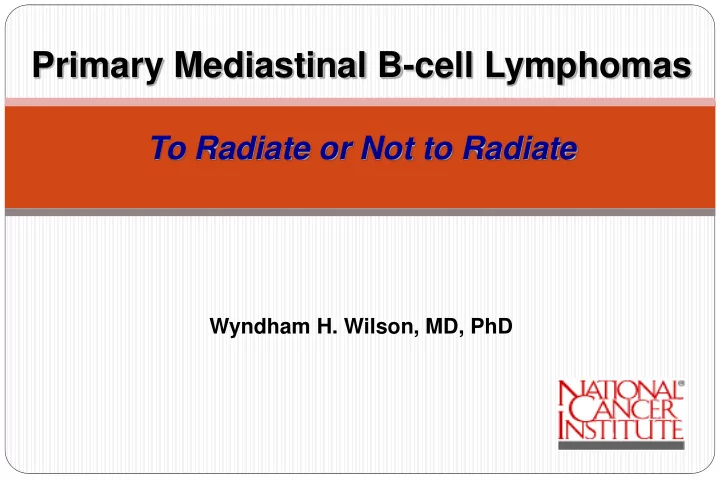

Primary Mediastinal B-cell Lymphomas To Radiate or Not to Radiate Wyndham H. Wilson, MD, PhD
Primary Mediastinal B-cell Lymphomas Molecular Subtype of DLBCL
R-CHOP is Not Adequate for PMBL The British Columbia experience • 153 patients • Median age 37 years • Bulky >= 10 cm 75% • Radiotherapy upfront 39% • Median follow-up 9 years Ann Oncol. 2005;17(1):123-130
Impact of Dose-Intensity Treatment • Effect of treatment • MACOPB/VACOPB • CHOP-R • CHOP Ann Oncol. 2005;17(1):123-130
R-CHOP is Not Adequate for PMBL The Harvard Experience • Number 63 • Median age 37 years • Median mass 11 cm • Radiation in responding patients 77% Leukemia & Lymphoma Vol 55, 583. 2014 • Median follow-up 69 months
EGF PET Predicts Survival in PMBL Results of Prospective IELSG26 Study • 125 patients • Median age 33 years • Bulky > 10 cm 52% • Treatment • MACOP-B-R 71 • VACOP-B-R 34 • CHOP-R 14 • Consolidation RT allowed JCO. 2013, 32:1762
EGF PET Predicts Survival in PMBL Results of Prospective IELSG26 Study
DA-EPOCH-R in PMBL No Need for Radiation National Cancer Stanford Medical Ins titute Phas e II Center Retros pective Characteris tics Study Study DA-EPOCH-R (%) DA-EPOCH-R (%) Total Patients 51 16 Female Gender 30 (59%) 9 (56%) Age years median [range] 30 [19-52] 33 [23-68] Bulky Tumor ≥ 10 cm [range] 33 (65%) [5-18] 9 (56%) [7-18] Stage IV disease 15 (29%) 7 (44%) Lactate Dehydrogenase > 40 (78%) 11 (69%) Normal Extranodal site 27 (53%) 3 (19%) Pleural effusion 24 (47%) 10 (63%) CD20+ malignant cells 51 (100%) 16 (100%) BCL-6+ malignant cells 33/37 (89%) Not Done Dunleavy et al, NEJM 2013
DA-EPOCH-R Obviates the Need for Radiation in PMBL Median follow-up 5 years Median follow-up 3 years Dunleavy et al, NEJM 2013
EOT FDG-PET with DA-EPOCH-R Untreated PMBL patients received DA-EPOCH-R without RT (N=93) Prospective NCI (N = 58); Retrospective Stanford (N = 34) EOT FDG-PET assessed by 2 independent nuclear medicine physicians blinded to clinical outcome 1 Dunleavy, K., et al. NEJM. 2013. 2 Meignan, M., Leuk Lymphoma. 2009.
Treatment Paradigm DA-EPOCH-R X 6 CT +PET PET Pos itive PET Sus picious PET Negative Biops y Repeat PET in 4-6 wks Routine f-up q3 mos Biopsy + XRT
EFS and OS for the Entire Cohort Event-Free Survival (EFS) Overall Survival (OS) 7-year EFS: 89.6% (95% CI: 80.0-94.8%) 7-year OS: 93.9% (95% CI: 84.2-97.7%)
EFS and OS by Institution Median potential follow-up = 7.0 years Overall Survival (OS) Event-Free Survival (EFS) p=0.71 p=0.29 7-year EFS: 7-year OS: NCI: 90.0% (95% CI: 77.3-95.8%) NCI: 95.1% (95% CI: 83.9-99.7%) Stanford: 89.8% (95% CI: 71.5-96.6%) Stanford: 92.4% (95% CI: 72.8-98.1%)
EFS and OS Based on EOT FDG-PET Overall Survival (OS) Event-Free Survival (EFS) p=0.046 p=0.34 7-year EFS: 7-year OS: Deauville 1-3: 91.8% Deauville 1-3: 93.4% Deauville 4-5: 80.0% Deauville 4-5: 91.3%
EOT FDG-PET Deauville 1-4 v 5 Overall Survival (OS) Event-Free Survival (EFS)
EOT FDG-PET Performance
Randomized R-CHOP versus DA-EPOCH-R Not Relevant to PMBL 0.8 Survival Probability 0.6 0.4 PMBL 5-6% 0.2 R-CHOP DA-EPOCH-R 0.0 0 1 2 3 4 5 Years from Study Entry
Problems with the Study • Poor compliance with DA-EPOCH-R R-CHOP DA-EPOCH-R P-value Completed per protocol* 85.9% 79% 0.037 PD during treatment 2.7% 1.5% 0.361 Early discontinuation due to AE 1.5% 6.5% 0.004 Max DA-EPOCH-R Dose level 1 28% 20% ↑ 2 20% 44% ↑ 3 23% 73% ↑ 4 17% 107% ↑ 5 9% 149% ↑ 6 2% 200% ↑ 7 <1%
Problems with the Study IPI outcome in DA-EPOCH-R % of Pts ALL R-CHOP DA-EPOCH-R P-value Age 0.073 ≤ 60 59 71% 73% 70% > 60 41 63% 65% 61% IPI <0.001 0-1 27 82% 90% 72% 2 38 70% 72% 68% 3 25 55% 50% 61% 4-5 10 53% 40% 60%
Problems with the Study IPI outcome in DA-EPOCH-R % of Pts ALL R-CHOP DA-EPOCH-R P-value Age 0.073 ≤ 60 59 71% 73% 70% > 60 41 63% 65% 61% IPI <0.001 0-1 27 82% 90% 72% 2 38 70% 72% 68% 3 25 55% 50% 61% 4-5 10 53% 40% 60%
Problems with the Study IPI outcome in DA-EPOCH-R % of Pts ALL R-CHOP DA-EPOCH-R P-value Age 0.073 ≤ 60 59 71% 73% 70% > 60 41 63% 65% 61% IPI <0.001 0-1 27 82% 90% 72% 2 38 70% 72% 68% 3 25 55% 50% 61% 4-5 10 53% 40% 60%
Conclusions DA-EPOCH-R obviates need for RT with EFS 90% and OS 94% 7-year median potential follow-up
Conclusions DA-EPOCH-R obviates need for RT with EFS 90% and OS 94% 7-year median potential follow-up Totality of data indicates PMBL like nsHL benefits from dose-intensive treatment
Conclusions DA-EPOCH-R obviates need for RT with EFS 90% and OS 94% 7-year median potential follow-up Totality of data indicates PMBL like nsHL benefits from dose-intensive treatment Totality of data with R-CHOP indicates need for RT in a significant subset
Conclusions DA-EPOCH-R obviates need for RT with EFS 90% and OS 94% 7-year median potential follow-up Totality of data indicates PMBL like nsHL benefits from dose-intensive treatment Totality of data with R-CHOP indicates need for RT in a significant subset RT associated with late toxicity and combined modality treatment is more costly than DA-EPOCH-R alone
Conclusions DA-EPOCH-R obviates need for RT with EFS 90% and OS 94% 7-year median potential follow-up Totality of data indicates PMBL like nsHL benefits from dose-intensive treatment Totality of data with R-CHOP indicates need for RT in a significant subset RT associated with late toxicity and combined modality treatment is more costly than DA-EPOCH-R alone DA-EPOCH-R should be the standard for PMBL
Acknowledgements National Cancer Institute Stanford Cancer Institute Wyndham H. Wilson Ranjana Advani Kieron Dunleavy Kelsey Walters Mark Roschewski Clara C. Chen Elaine S. Jaffe Stefania Pittaluga Seth M. Steinberg Margaret (Peggy) Shovlin Joan Aaron Nicole Lucas
Recommend
More recommend